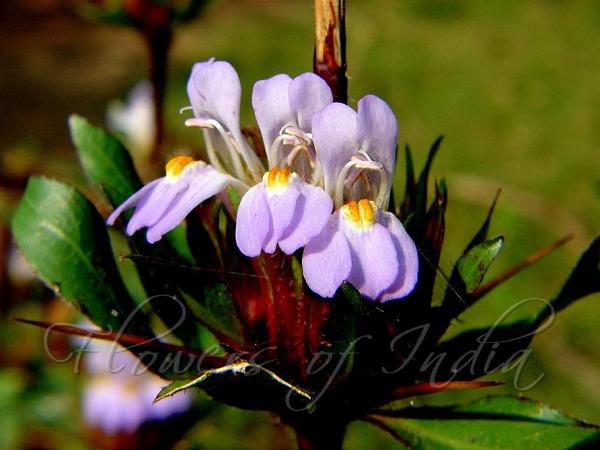|
| Marsh Barbel |
|

|

| File size | 94340 |
| Original date | 10/19/06 9:22 AM |
| Resolution | 1024 x 683 |
| Flash | Flash did not fire, auto |
| Focal length | 6.0mm |
| Exposure time | 1/320s |
| Aperture | 4.0 |
| Focus Distance | |
| Metering Mode | Multi-segment |
| Camera make | SONY |
| Camera model | DSC-H1 |
| Sensor type |
|
|
|
|
Photo: |
Botanical name: Hygrophila auriculata Family: Acanthaceae (Acanthus family)
Synonyms: Hygrophila schulli, Hygrophila spinosa, Hygrophila schulli var. alba
Synonyms: Hygrophila schulli, Hygrophila spinosa, Hygrophila schulli var. alba
Marsh Barbel is a stout aquatic perennial herb, 1-2
m high. Erect unbranched stems are hairy near swollen nodes. Densely
hairy, lance-like, stalkless leaves, 10-15 cm long, occur in whorls of
6 at each node on the stem. Straight, yellow, 4 cm long spines are
present in the axil of each leaf. Flowers occur in 4 pairs at each
node. The 3 cm long purple-blue flowers are 2-lipped - the upper lip is
2-lobed and the lower one 3-lobed with lengthwise folds. Flowers open
in opposite pairs. Flowering: October-April.
Medicinal uses: Kokilaksha, as it is known in
sanskrit, was extensively used in Ayurvedic system of medicine for
various ailments like rheumatism, inflammation, jaundice, hepatic
obstruction, pain, etc.
Kokilaksha, as it is known in
sanskrit, was extensively used in Ayurvedic system of medicine for
various ailments like rheumatism, inflammation, jaundice, hepatic
obstruction, pain, etc.
Medicinal uses:
 Kokilaksha, as it is known in
sanskrit, was extensively used in Ayurvedic system of medicine for
various ailments like rheumatism, inflammation, jaundice, hepatic
obstruction, pain, etc.
Kokilaksha, as it is known in
sanskrit, was extensively used in Ayurvedic system of medicine for
various ailments like rheumatism, inflammation, jaundice, hepatic
obstruction, pain, etc. | Identification credit: Pravin Kawale | Photographed in Maharashtra, Bengal & Gujarat. |
• Is this flower misidentified? If yes,